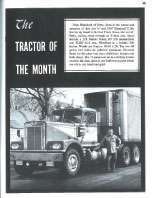 Plainfield, Ill.-based owner-operator Bob “Mighty Rat” Ratterree told Overdrive his 1987 Autocar was “built like a tank.” The truck was Tractor of the Month in the November 1987 issue. It was equipped with a 425-hp Caterpillar and a 13-speed Eaton transmission.
Plainfield, Ill.-based owner-operator Bob “Mighty Rat” Ratterree told Overdrive his 1987 Autocar was “built like a tank.” The truck was Tractor of the Month in the November 1987 issue. It was equipped with a 425-hp Caterpillar and a 13-speed Eaton transmission.For Overdrive readers, the road to Paradise has always been populated with their dependable, good-looking rigs. BY LUCINDA COULTER
Readers writing letters to the editor in Overdrive’s early issues often oozed enthusiasm for featured rigs, requested reviews of specific trucks and were not bashful about submitting photos of their own equipment.
 Leonard Davis’ 1952 LF Mack, equipped with a 505-hp Cummins, graced the February 1966 cover as Tractor of the Month for its mint condition and, apparently, being well equipped with the wireless tools of the day. Davis had a Chevrolet standard broadcast radio, an amateur radio receiver, a short wave FM receiver, a Regency citizens band radio and a General Electric 9-inch TV.
Leonard Davis’ 1952 LF Mack, equipped with a 505-hp Cummins, graced the February 1966 cover as Tractor of the Month for its mint condition and, apparently, being well equipped with the wireless tools of the day. Davis had a Chevrolet standard broadcast radio, an amateur radio receiver, a short wave FM receiver, a Regency citizens band radio and a General Electric 9-inch TV.“Since I was knee high to a grasshopper, I’ve wanted to be a trucker, especially long haul. My favorite rig is the F model Mack,” wrote Canadian Paul Comeau of Digby, Nova Scotia, in the October 1965 issue, following Overdrive’s “dissection” of that model. “Charlie Miller’s Tractor of the Month [August] sure would be a dream fulfilled for me.”
Readers’ suggestions for making a perfect Class 8 tractor and editors’ reviews of equipment trends figured prominently in the magazine. Departments such as Tractor of the Month and Reader Rigs kept readers’ trucks in the limelight throughout the years.
To bring attention to the finest customized owner-operator trucks, Overdrive launched Pride & Polish in 1990. It was the first truck beauty show held at a major trucker convention, and continues today under Overdrive’s Custom Rigs magazine.
 Owner-operator John Blanchard, of Perry, Iowa, leased to Morton Truck Lines to haul meat with his 1967 Diamond T, took Overdrive June 1968 Tractor of the Month honors. Blanchard’s truck was made the year White Motor Corp., which owned Diamond T, introduced the Diamond Reo Truck Division.
Owner-operator John Blanchard, of Perry, Iowa, leased to Morton Truck Lines to haul meat with his 1967 Diamond T, took Overdrive June 1968 Tractor of the Month honors. Blanchard’s truck was made the year White Motor Corp., which owned Diamond T, introduced the Diamond Reo Truck Division. Team drivers Carol and R.K. Fitzpatrick modeled turquoise jewelry in front of their 108-inch double-sleeper Kenworth, which they leased to Tri-State Motor Transit in Joplin, Mo. The couple’s rig won Tractor of the Month in Overdrive’s November 1974 issue.
Team drivers Carol and R.K. Fitzpatrick modeled turquoise jewelry in front of their 108-inch double-sleeper Kenworth, which they leased to Tri-State Motor Transit in Joplin, Mo. The couple’s rig won Tractor of the Month in Overdrive’s November 1974 issue.
1963: Twin countershaft transmission BY JOHN BAXTER

Eaton’s Fuller division had excited the trucking world with the Roadranger range shift concept in the mid-1950s, doing away with the awkward twin-stick shifts of earlier years. The two-countershaft redesign was not obvious to the driver, but the industry still benefits from it in terms of transmission size and weight, as well as shifting ease.
 50 YEARS OF EQUIPMENT INNOVATIONS The first Fuller Roadranger twin countershaft transmission.
50 YEARS OF EQUIPMENT INNOVATIONS The first Fuller Roadranger twin countershaft transmission.The unit was a product of the cabover era and the need for short overall length in combination with ever-escalating diesel engine torque output. The ingenious design provided tremendous torque capacity in a small package.
Every transmission has an input shaft coming from the clutch and an output shaft that turns the driveshafts. The countershaft transmits the power between the two, unless the unit is in direct drive. By adding a countershaft, and placing one on each side of the mainshaft gears, Eaton’s design doubled the number of teeth carrying the torque on each mainshaft gear.
The design allowed thinner, lighter gears and packed more ratios into a much shorter housing. It also allowed the mainshaft gears to float on their teeth between adjacent countershaft gears when not engaged, eliminating one bearing for each mainshaft gear. The floating design also reduced shifting by helping gears to center themselves as the shift collars slid into position during shifts.
Modern truck transmissions still carry the design, even with long conventional tractors. Imitators began using the concept – even expanding it to triple countershafts – once the original patent expired.











